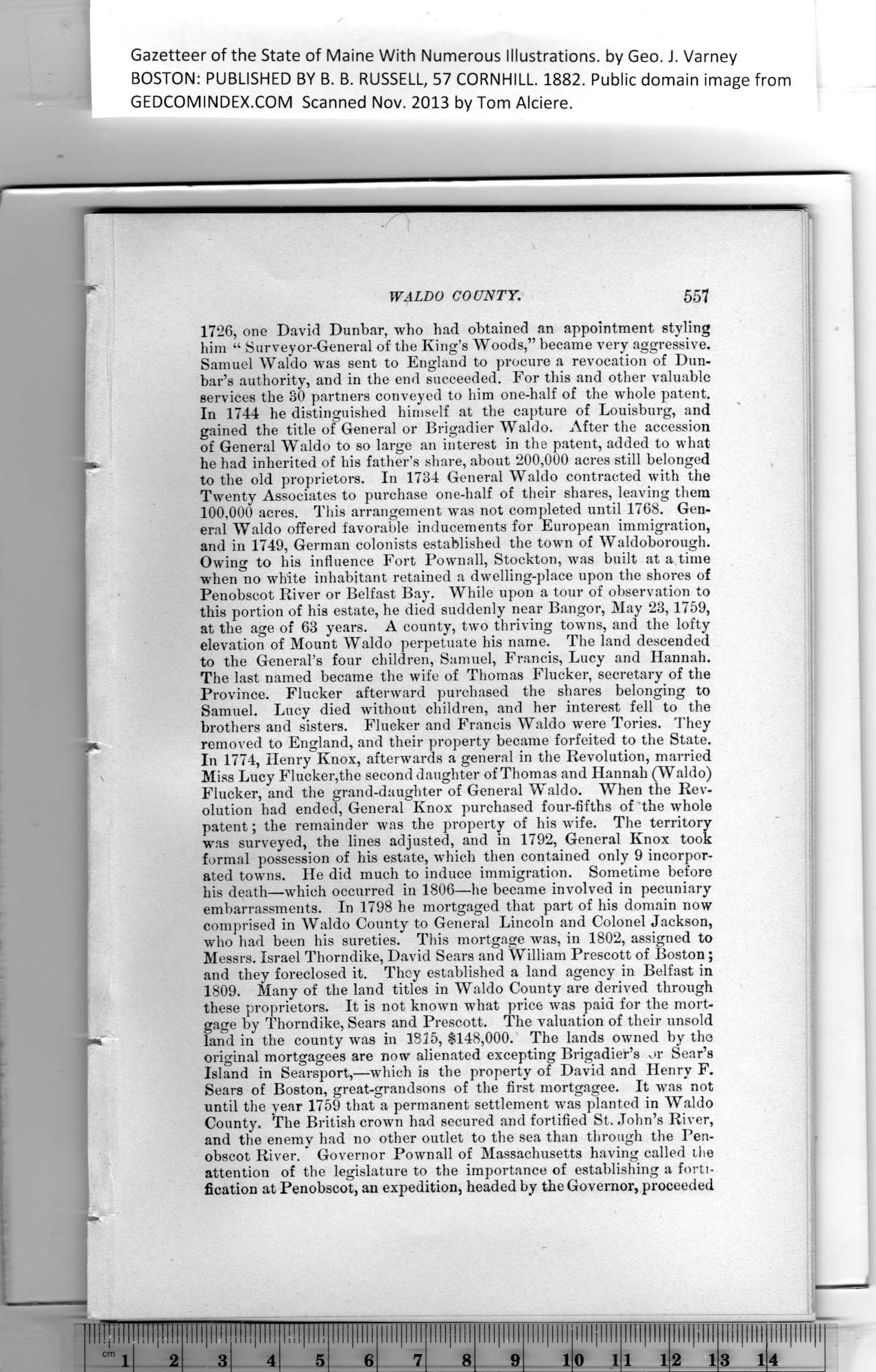|
Gazetteer of the State of Maine With Numerous Illustrations, by Geo. J. Varney
BOSTON: PUBLISHED BY B. B. RUSSELL, 57 CORNHILL. 1882. Public domain image from
WALDO COUNTY. 557
1726, one David Dunbar, who had obtained an appointment styling
him “ Surveyor-General of the King’s Woods,” became very aggressive.
Samuel Waldo was sent to England to procure a revocation of Dun-
bar’s authority, and in the end succeeded. For this and other valuable
services the 80 partners conveyed to him one-half of the whole patent.
In 1744 he distinguished himself at the capture of Louisburg, and
gained the title of General or Brigadier Waldo. After the accession
of General Waldo to so large an interest in the patent, added to what
he had inherited of his father’s share, about 200,000 acres still belonged
to the old proprietors. In 1784 General Waldo contracted with the
Twenty Associates to purchase one-half of their shares, leaving them
100,000 acres. This arrangement was not completed until 1768. Gen-
eral Waldo offered favorable inducements for European immigration,
and in 1749, German colonists established the town of Waldoborough.
Owing to his influence Fort Pownall, Stockton, was built at a time
when no white inhabitant retained a dwelling-place upon the shores of
Penobscot River or Belfast Bay. While upon a tour of observation to
this portion of his estate, he died suddenly near Bangor, May 23, 1759,
at the age of 63 years. A county, two thriving towns, and the lofty
elevation of Mount Waldo perpetuate his name. The land descended
to the General’s four children, Samuel, Francis, Lucy and Hannah.
The last named became the wife of Thomas Flucker, secretary of the
Province. Flucker afterward purchased the shares belonging to
Samuel. Lucy died without children, and her interest fell to the
brothers and sisters. Flucker and Francis Waldo were Tories. They
removed to England, and their property became forfeited to the State.
In 1774, Henry Knox, afterwards a general in the Revolution, married
Miss Lucy Flucker,the second daughter of Thomas and Hannah (Waldo)
Flucker, and the grand-daughter of General Waldo. When the Rev-
olution had ended, General Knox purchased four-fifths of the whole
patent; the remainder was the property of his wife. The territory
was surveyed, the lines adjusted, and in 1792, General Knox took
formal possession of his estate, which then contained only 9 incorpor-
ated towns. He did much to induce immigration. Sometime before
his death—which occurred in 1806—he became involved in pecuniary
embarrassments. In 1798 he mortgaged that part of his domain now
comprised in Waldo County to General Lincoln and Colonel Jackson,
who had been his sureties. This mortgage was, in 1802, assigned to
Messrs. Israel Thorndike, David Sears and William Prescott of Boston;
and they foreclosed it. They established a land agency in Belfast in
1809. Many of the land titles in Waldo County are derived through
these proprietors. It is not known what price was paid for the mort-
gage by Thorndike, Sears and Prescott. The valuation of their unsold
land in the county was in 1825, $148,000. The lands owned by the
original mortgagees are now alienated excepting Brigadier’s or Sear’s
Island in Searsport,—which is the property of David and Henry F.
Sears of Boston, great-grandsons of the first mortgagee. It was not
until the year 1759 that a permanent settlement was planted in Waldo
County. The British crown had secured and fortified St. John’s River,
and the enemy had no other outlet to the sea than through the Pen-
obscot River. Governor Pownall of Massachusetts having called the
attention of the legislature to the importance of establishing a forti-
fication at Penobscot, an expedition, headed by the Governor, proceeded
PREVIOUS PAGE ... NEXT PAGE
This page was written in HTML using a program written in Python 3.2
|
